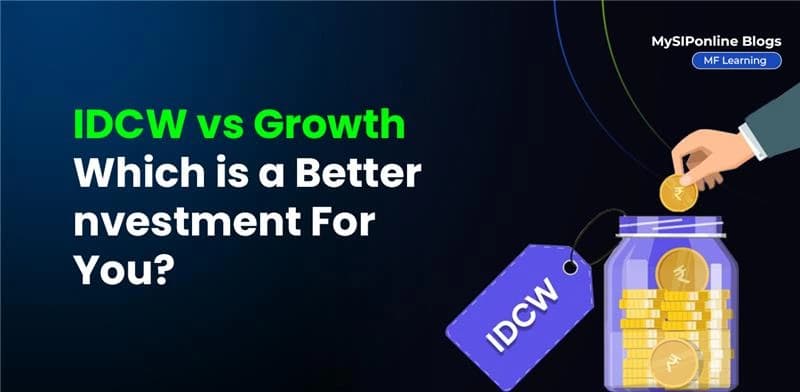Table of Contents
- What is the Growth Option?
- Features of the Growth Options
- What is the IDCW?
- Features of IDCW (Income Distribution Cum Capital)
- What is the Difference Between IDCW and Growth Option?
- Understanding IDCW and Growth Options With an Example
- IDCW vs Growth Option: Which is Better Investment?
- Can You Switch Between IDCW and Growth Options?
- Conclusion
Do you find it challenging to choose between IDCW vs Growth Options when investing in Mutual Funds? If yes, then you have come across the right handbook.
This post will provide a detailed comparison of IDCW and growth options along with a workable example, which will help you choose the most suitable option for yourself.
But for starters, the primary difference between IDCW and growth options lies in profit distribution. One provides you with a regular income and another reinvests your profits thus creating wealth in the long term.
Keep reading and you will learn some interesting features of both IDCW and growth options as well.
What is the Growth Option?
The growth option in mutual funds reinvests your profits in the same scheme. This way, your investment money is appreciated over the long term. This is a tactical way to keep investing in companies that hold the potential to generate great returns in the future. This way, investors can create wealth for their future.
Features of the Growth Options
The following features make growth options a gateway to wealth creation:
1. Profits Get Reinvested
The growth option of mutual funds in SIP reinvests your profits into the same scheme. This way, over the term, you can create substantial wealth.
2. Greater Capital Gains
The power of compounding is another key feature of growth options. Investors can start from a very small amount and earn great capital in the long term.
3. Increased NAV
The Net Asset Value or NAV can get very high in the growth options. Since the profits get invested back into the fund, it increases the NAV for growth options.
4. Higher Tax Efficiency
For long-term investors, the growth options can save their money from taxation. Due to the reinvestment of profits, tax efficiency increases for long-term capital gains.
Pro Tip: Plan like a pro with SIP Calculator simplifying complex calculations in seconds.
What is the IDCW?
IDCW stands for Income Distribution Cum Capital. In this option, you can receive certain income at regular intervals. These pay-outs are a small part of the profits that mutual funds make. Investors like retired professionals can ensure a regular source of income through IDCW.
Features of IDCW (Income Distribution Cum Capital)
The following are the features of IDCW in mutual funds:
1. Regular Income
Investors can receive payouts from the profits of their investments. These incomes get distributed in periodic intervals. For example, monthly or quarterly. It depends on investors how they want their payouts.
2. Option to Withdraw Principle
Through IDCW in mutual funds, investors can also withdraw principal money. This feature provides investors with the option to withdraw from the scheme.
3. Taxation
As compared to growth options, IDCW gets taxed under applicable tax slabs. Hence, investors need to consider their tax liability if they opt for IDCW.
4. Market-Dependency
Investors cannot receive IDCW in mutual funds as per their choice of intervals. It depends on the market conditions. Any fluctuation in the market can affect the fund's performance, and thus the income as well.
What is the Difference Between IDCW and Growth Option?
IDCW can be considered as an income but not promised in all circumstances. Growth options, on the other hand, allow investors to reinvest their profits, thus increasing their investment amount over time.
To further grasp a stronghold of growth option vs IDCW, refer to the following table:
| Features | IDCW | Growth Options |
|---|---|---|
| Returns | No guaranteed income due to market volatility | Returns reinvested back into the fund |
| Tax Deductions | Tax is deducted as per the income slab | Taxation depends on the duration of investment and the class of asset |
| Suitable Investment | A possible source of regular income, but not ensured all-time | Creates wealth for the future |
| Change in NAV | NAV is reduced after profit distribution as a deduction occurs from the assets of the fund | A higher value of NAV due to reinvestment of profits |
Now that you have understood the difference between IDCW and growth options. Are you able to decide “Which is better for you?”
If not, it is understandable. Let’s take an example that will give you more clarity.
Understanding IDCW and Growth Options With an Example
Let's say the Net Asset Value of a mutual fund on 24/03/25 is Rs 50. You invest Rs 50,000 in this fund. This means you have bought 1,000 units of the fund.
By the next year, the NAV of that fund becomes Rs.60, which means you have earned a certain profit from this increment. The dividend you get on each unit is Rs 10 and this is IDCW for you. But if you choose the growth option, this profit will be reinvested in the same fund.
After you receive the dividend from IDCW in mutual funds, the NAV of the fund again reduces to Rs 50 although you have received an income of Rs 10,000. Whereas in the case of growth options, it remains Rs.60.
If you calculate, the units issued against the dividends:
10,000/50 = 200
This means you have received an income worth 200 units of the fund you invested in. In growth options, since the profits were reinvested, the fund units are higher.
The total number of units you hold in IDCW is 800, as compared to the initial value which was 1000 units. If you calculate your total value of investment now:
IDCW option -
800*50= Rs 40,000
Whereas, the total value of an investment in the case of the growth option is:
1000*60= Rs 60,000
You can see the huge difference between IDCW and growth options values. Although investors get an income in the case of IDCW it reduces the value of their investment as well.
So why wait, when you can start planning early and better for your family’s future now?
Start Your SIP TodayLet your money work for you with the best SIP plans.
Now, should you go for an income or create wealth for your future? The next part will give you the answer.
IDCW vs Growth Option: Which is Better Investment?
When it comes to IDCW vs growth options, growth options can be better for investors as they can create wealth in the long term through them. Through growth options, investors can secure their future.
However, some investors may be looking for a regular source of income that can help them cope with rising inflation and cost of living. For them, IDCW is a good option. The following points will help you identify a suitable option between IDCW and the growth option.
- If you can wait for a long duration, let's say, you want to invest until your retirement or want to secure your children's education. The growth options will help you achieve such financial goals.
- But if you want to repay your debts as quickly as possible or to maintain an emergency fund. Then choose IDCW in mutual fundsas it can help you reduce your financial burdens.
- If you fall in a lower tax bracket then go for the growth option. You will have to pay less tax on your capital gains. But if you come under a high tax bracket, then choose IDCW and save your money. IDCWs are considered dividends and hence not taxed under capital gains.
So far, we have discussed IDCW vs growth options and their features. You also know about their differences and which is better for you. However, some investors may have already opted for one of these options.
Are you thinking of switching? Read the next heading to find out if it's all possible or not.
Can You Switch Between IDCW and Growth Options?
The answer to this question is a straight yes. You can switch between IDCW and growth options within the mutual funds scheme. But you will have to keep these things in your mind:
1. Taxation Rule
If you choose between the two options, then your capital gains may be taxed before you switch. Since such switching is called redemption. It means you are repaying the fund you have bought and buying your investment back again. Hence, it has to be taxed. The amount of tax deduction will depend on the duration you stayed in the fund before you switched.
2. Exit Charges
If you decide to switch between IDCW vs growth options, you may face exit charges from the fund house. This rule depends on the duration of your investment. You are strongly recommended to go through the terms and conditions. Look for any extra fees that you will have to pay if you switch.
3. NAV Calculations
After you switch, the number of units you hold in that mutual fund may vary. So don't panic and think about your objectives and the benefits you will get from switching. Less does not always mean loss.
There is no need to worry if you have opted for one of the options, but now want to switch. Just rethink your financial goals. Analyze your priorities, calculate the risks, and switch accordingly between IDCW vs growth options.
Conclusion
To wrap up, while picking which option suits you best on IDCW vs Growth Option, consider the above-discussed factors that fit your investing style, risk tolerance, and income needs. Both alternatives serve their own benefits and cater to a wide range of investors.
Also Read :











.webp&w=3840&q=75)


